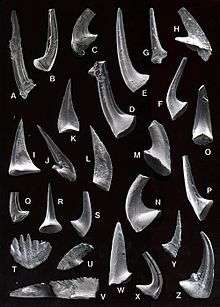Acanthodus
| Acanthodus Temporal range: Late Cambrian–Early Ordovician | |
|---|---|
 | |
| W: Acanthodus uncinatus Furnish; lateral view of non-serrate suberectiform element, from upper part of middle Gasconade Dolomites at Phillips Quarry, X 50, USNM 498518. | |
| Scientific classification | |
| Kingdom: | Animalia |
| Phylum: | Chordata |
| Class: | †Conodonta |
| Order: | †Protopanderodontida |
| Family: | †Acanthodontidae |
| Genus: | †Acanthodus Furnish, 1938[1] |
| Species | |
| |
Acanthodus is an extinct genus of conodonts.
Acanthodus humachensis and A. raqueli are from then Late Cambrian (late Furongian) or early Ordovician (Tremadocian) of the Santa Rosita Formation in Argentina.[2]
References
- ↑ Conodonts from the Prairie du Chien (Lower Ordovician) beds of the upper Mississippi valley. WM Furnish, Journal of Paleontology, volume 12, No. 4, July 1938, pages 318-340 (Stable URL)
- ↑ New conodont species and biostratigraphy of the Santa Rosita Formation (upper Furongian–Tremadocian) in the Tilcara Range, Cordillera Oriental of Jujuy, Argentina. Fernando J. Zeballo and Guillermo L. Albanesi, Geological Journal, 2013, volume 48, issue 2–3, pages 170–193, doi:10.1002/gj.2425
External links
- Acanthodus at the Encyclopedia of Life
- Acanthodus at fossilworks.org (retrieved 25 June 2016)
This article is issued from
Wikipedia.
The text is licensed under Creative Commons - Attribution - Sharealike.
Additional terms may apply for the media files.